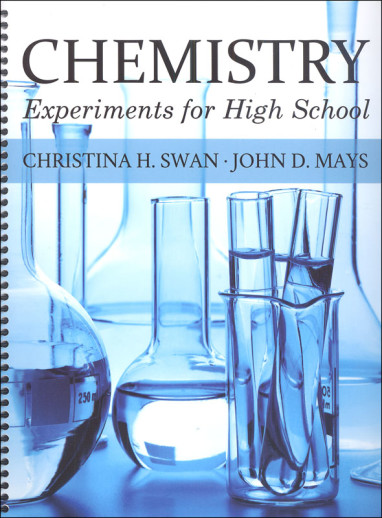We use cookies to make your experience better. To comply with the new e-Privacy directive, we need to ask for your consent to set the cookies. Learn more.
Chemistry Experiments for High School
A laboratory practicum incorporating a series of quantitative experiments is an essential component of any high school or college chemistry course. It is one thing to read about precipitations; it is another thing to see the precipitates form with your own eyes. Lab experience also provides students with practice using standard laboratory apparatus and methods. Finally, there is nothing like laboratory practice to give students a feel for how the stoichiometric calculations learned in the classroom relate to the predictions and results of an actual experiment
This manual is the student's guide to accompany General Chemistry and Chemistry for Accelerated Students. Included are instructions for 20 experiments, materials lists, safety issues, discussion questions and more. Pages are perforated for easy removal of the Short Form Report Sheet which is to be filled out and turned in after each experiment.
The experiments in this manual are designed for schools with standard laboratory facilities and equipment. If your school or home does not yet have such facilities, we suggest you take a look at our other experiments book, Chemistry Experiments for High School at Home (CEHSH). The experiments in CEHSH are rigorously quantitative, just as they are in CEHS.
For chemistry, or any high school science experiment, we recommend The Student Lab Report Handbook as a companion guide to show students how to prepare excellent lab reports.
Novare (no-VAH-ray) is Latin, meaning to renew or begin again. The authors feel that science education in our country needs to be renewed using research, scientific evidence and forward-thinking strategies while keeping God at the helm. Students are taught to see God in creation, while learning current scientific theories that support an old-earth creation. Using a mastery approach, students learn fewer topics in more depth than typical courses. Memorization and review are key with minimal written work. Science, math, science history, and English language usage are integrated. Several Novare courses are used by Memoria Press for their academic rigor and are a good choice for students who need challenging science courses and college prep. Each course offers a recommended downloadable Digital Resource that includes assessments and course planning resources that are helpful for homeschool families, co-ops and classrooms. Resources are reproducible for classroom use. Self-created lab journals and reports are suggested to prepare students for high school and college science material. Also available is a helpful Student Lab Report Handbook for more instruction. See each individual course for content and available supports.
Intended for use at the 11th grade level, this mastery-based chemistry course from Novare Science & Math takes a bit of a different approach from other chemistry courses. He promotes a physics-first approach and suggests Introductory Physics (also by Novare) be taken in 9th grade, biology in 10th, followed by this course in 11th. The author suggests taking this course concurrently with Algebra 2.
By following the author's suggestion of physics-first, the student can more easily work through General Chemistry and have a greater understanding of the concepts. Novare employs a mastery approach - students should learn, master, and retain what they learn. Curricula that uses this approach covers fewer topics and covers them more deeply. This text also integrates learning by combining skills in science, math, science history, and English language usage. Written from a Biblical worldview, the text seeks to help students see God in the world. The author holds to the view that the world is billions of years old and believes there is evidence for such. That being said, he doesn't address that topic in this text.
Chapters include: What is Chemistry All About, Measurements, Atoms & Substances, Atomic Structure, Periodic Law, Chemical Bonding, Molecular Theory and Metallic Bonding, Chemical Reactions and Stoichiometry, Kinetic Theory and States of Matter, Gas Laws, Solution Chemistry, Acids and Bases, and Redox Chemistry. Answers to selected exercises are found in the back of the text along with some helpful information in the appendices. It is very important to read the teacher and student information found in the preface of the text - this is where you will get a thorough explanation of the philosophy of the author and the best way to use the text. Every chapter begins with stated objectives, presents the information into smaller chunks that are offered in numbered sections, and rounds out the chapter with study questions. The author believes in questions that require complete sentences as a response, so you won't find any true/false, matching, or multiple choice questions. The 400-page text is smaller than some (7"x 10") so the print is smaller, and there are colored illustrations throughout.
There are also downloadable Digital Resources available as a separate purchase. Previously sold as a "Resource CD," these files include PDF format quizzes, exams, term exams (2), and answer keys for all. There is also "Recommendations for Teaching General Chemistry," most of which is taken from the preface in the text.
Typically, you need a lab component with chemistry courses. There is nothing written into the text for labs, but the author recommends Chemistry Experiments for High School at Home for those who are homeschooling. This book has low-cost alternatives to expensive equipment and recommendations for procuring small quantities of chemicals. The Solutions Manual contains fully worked solutions for the computational problems found in the text. Novare courses are used by Memoria Press for their academic rigor and are a good choice for students who need challenging science courses and college prep. ~ Donna
| Product Format: | Paperback |
|---|---|
| Brand: | Novare Science and Math |
| Grades: | 11-12 |
| ISBN: | 9780990439769 |
| Length in Inches: | 11 |
| Width in Inches: | 9 |
| Height in Inches: | 0.875 |
| Weight in Pounds: | 1.1 |

